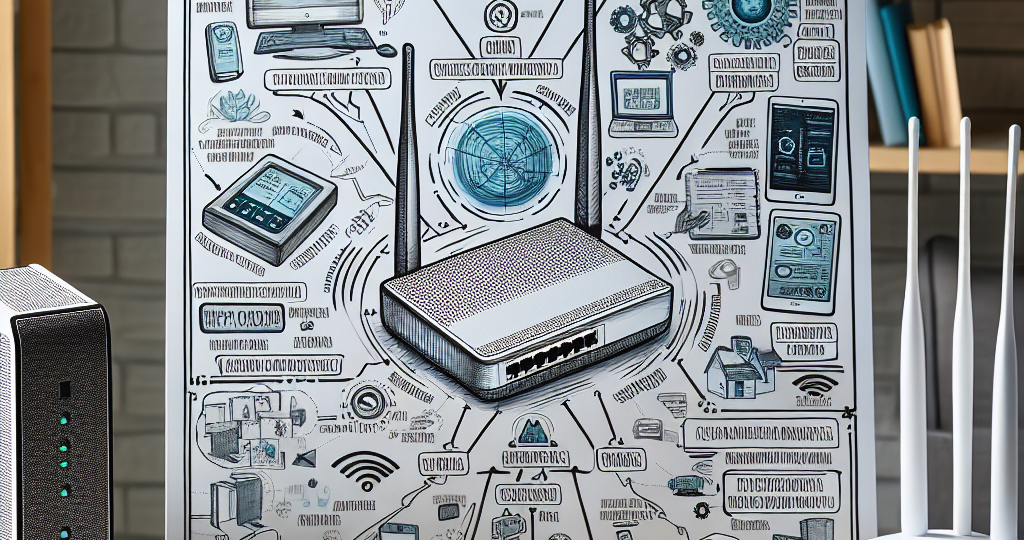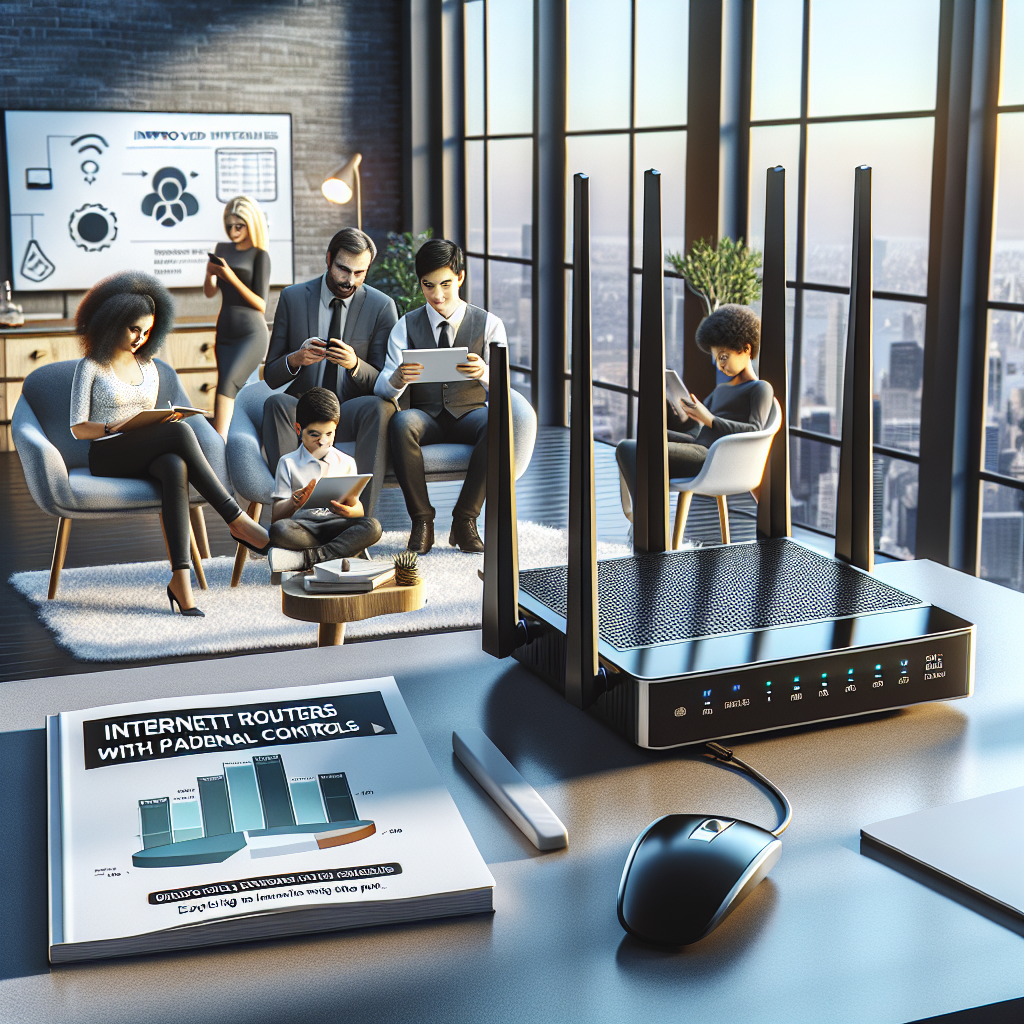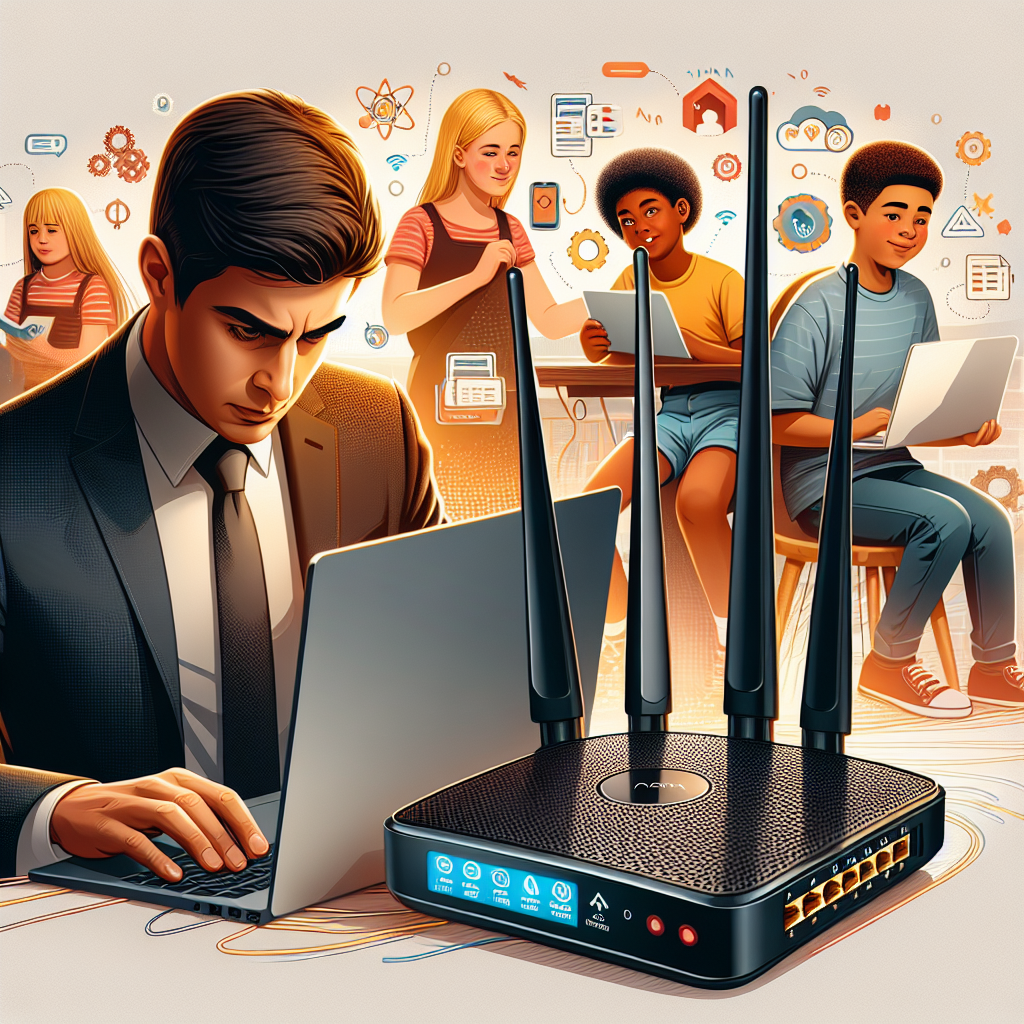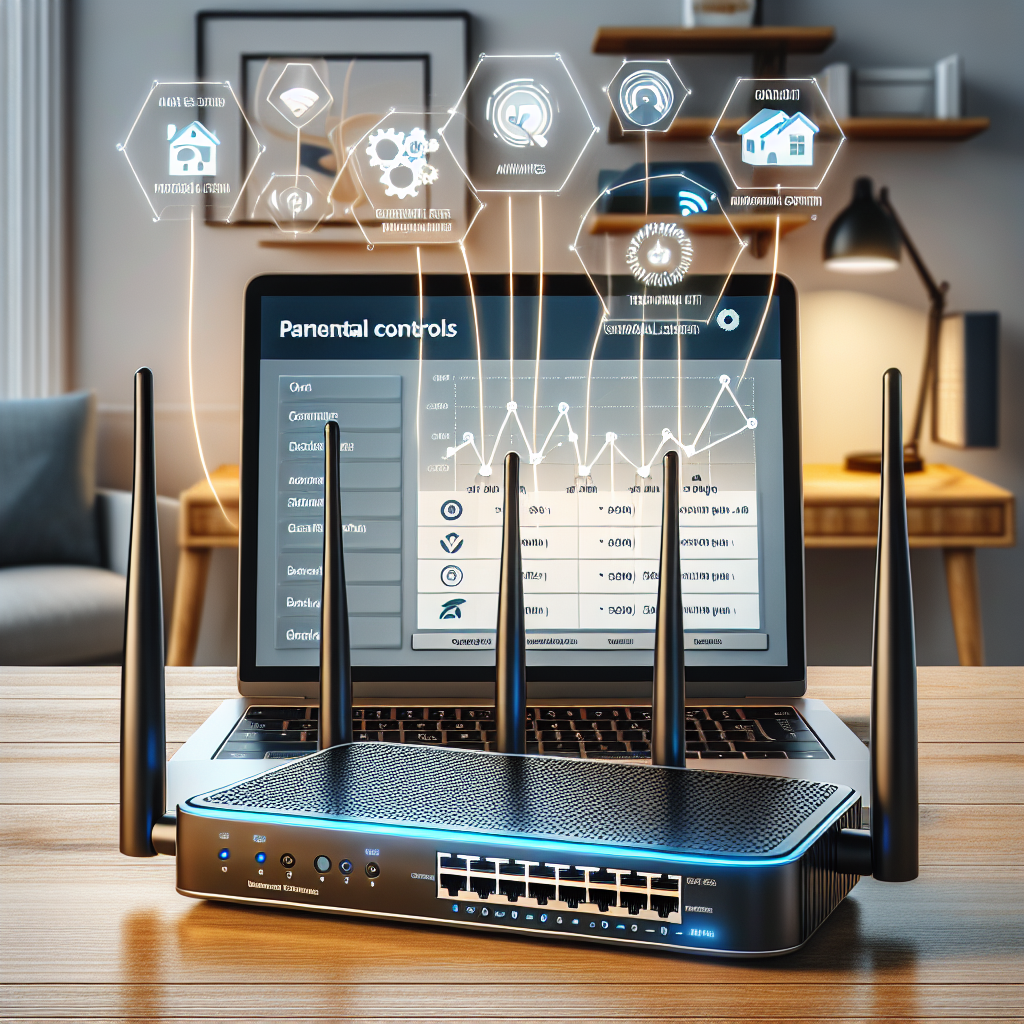Exploring the Benefits of Internet Routers with Parental Controls: A Comprehensive Guide
September 12, 2024 | by Linda Bednar

In today’s digital age, ensuring the online safety of our loved ones is more important than ever. Internet routers with parental controls offer a comprehensive solution to monitor and manage the online activities of children and teenagers. From limiting screen time to blocking inappropriate content, these devices provide peace of mind for parents while allowing for a safer browsing experience for the whole family. This guide will explore the numerous benefits of using an internet router with parental controls, from protecting against cyberbullying to fostering healthy online habits. Join us on this journey to discover how technology can help safeguard our digital lives.
Understanding the Role of Internet Routers with Parental Controls
Definition of Internet Routers with Parental Controls
Internet routers with parental controls refer to networking devices that provide the capability to manage and restrict the online activities of users within a household. These routers come equipped with specialized features that allow parents or guardians to set specific rules and filters to regulate internet access for children. By leveraging advanced technology, these routers enable users to monitor, control, and customize the online experience to ensure a safer and more secure browsing environment for minors. They serve as a vital tool in promoting responsible internet usage and safeguarding young individuals from potentially harmful content or online threats.
Importance of Parental Controls in Internet Usage
Parental controls play a crucial role in managing and monitoring the online activities of children and teenagers. In today’s digital age, where access to the internet is almost ubiquitous, ensuring a safe online environment is paramount. Here are some key points highlighting the importance of parental controls in internet usage:
-
Protection from Inappropriate Content: Parental controls help block access to explicit or harmful content such as violence, pornography, or gambling sites, safeguarding young users from exposure to inappropriate material.
-
Managing Screen Time: With the proliferation of devices and screens, parental controls enable parents to set limits on screen time, promoting a healthy balance between online and offline activities.
-
Preventing Cyberbullying: By monitoring social media interactions and online communication, parental controls can help detect and prevent instances of cyberbullying, protecting children from online harassment.
-
Ensuring Privacy and Security: Parental controls assist in safeguarding personal information and sensitive data by blocking malicious websites and preventing unauthorized access to confidential details.
-
Promoting Responsible Online Behavior: By setting restrictions on certain websites or monitoring search history, parental controls encourage responsible internet usage and help educate children about digital citizenship and online etiquette.
-
Peace of Mind for Parents: Parental controls offer parents peace of mind knowing that they can actively supervise their children’s online activities, even when they are not physically present, fostering a sense of security and trust in the digital realm.
In conclusion, parental controls play a vital role in shaping a safe and secure online environment for children and adolescents, empowering parents to guide and support their digital journey effectively.
Key Features to Look for in Internet Routers with Parental Controls

Content Filtering Options
Content filtering is a crucial aspect of parental controls on internet routers, allowing parents to regulate the type of content that can be accessed through their network. When selecting an internet router with parental controls, it is essential to consider the following content filtering options:
-
URL Filtering: This feature enables parents to block access to specific websites by blacklisting or whitelisting URLs. It provides granular control over the websites that can be visited, ensuring that children are not exposed to inappropriate content.
-
Keyword Filtering: Keyword filtering allows parents to block access to websites or content that contain specific keywords deemed unsuitable for children. By creating a list of prohibited keywords, parents can prevent their children from accessing harmful or explicit material online.
-
Category-Based Filtering: Internet routers with parental controls often offer category-based filtering, allowing parents to block entire categories of websites such as gambling, adult content, or social media. This feature simplifies the process of content filtering by enabling parents to apply restrictions based on predefined categories.
-
Time-Based Restrictions: Some internet routers with parental controls include time-based restrictions that allow parents to set specific times when internet access is permitted or restricted. This feature helps parents manage their children’s screen time and ensure that they are not accessing inappropriate content during designated hours.
-
Safe Search Enforcement: Parental control routers may offer safe search enforcement, which ensures that search engine results are filtered to exclude explicit content. This feature helps parents maintain a safer browsing experience for their children by preventing them from inadvertently accessing inappropriate images or websites through search engines.
By leveraging these content filtering options, parents can effectively monitor and control their children’s online activities, creating a safer and more secure internet environment within their homes.
Time Management and Scheduling Tools
Internet routers equipped with parental controls offer advanced time management and scheduling tools that empower parents to regulate their children’s online activities effectively. These features provide a structured approach to managing screen time and ensuring that children strike a healthy balance between online and offline pursuits. Here are some key details regarding the time management and scheduling tools found in internet routers with parental controls:
-
Customizable Access Schedules: Parents can create customized schedules based on their family’s routines and preferences. This functionality allows them to set specific times when internet access is permitted or restricted for individual devices connected to the network.
-
Time Limits: Internet routers with parental controls enable parents to set time limits for each device, helping prevent excessive screen time. Once the allocated time is reached, the device may either be automatically disconnected from the internet or restricted from accessing certain websites or applications.
-
Bedtime Controls: Another essential feature is bedtime controls, which allow parents to establish bedtime routines by automatically pausing internet access during designated hours. This helps ensure that children get adequate rest without the distractions of late-night screen time.
-
Pause Button: Some routers come equipped with a convenient pause button that instantly suspends internet connectivity across all devices. This feature is particularly useful during family meals, study sessions, or other times when uninterrupted focus is desired.
-
Usage Reports: Comprehensive usage reports provide insights into each connected device’s online activities, including the websites visited, the duration of internet usage, and the applications used. This information equips parents with valuable data to make informed decisions about managing screen time effectively.
Access Controls and Website Blocking Capabilities
When considering Internet routers with parental controls, the access controls and website blocking capabilities are vital features to examine. These functionalities empower parents to regulate and monitor their children’s online activities effectively. Here are some key points to consider:
-
Customizable Access Controls: Advanced routers offer customizable access controls that allow parents to set specific times when the internet can be accessed. This feature enables parents to establish healthy screen time limits for their children.
-
Website Blocking: Internet routers with parental controls often come equipped with website blocking capabilities. This feature enables parents to block access to inappropriate or harmful websites, ensuring a safer browsing experience for their children.
-
Keyword Filtering: Some routers allow parents to set up keyword filters to block access to websites containing specific keywords or phrases. This feature adds an extra layer of protection against potentially harmful online content.
-
Usage Reports: Many routers provide detailed usage reports that allow parents to track their children’s online activities. These reports can include information on websites visited, time spent online, and the devices used, giving parents valuable insights into their children’s digital behavior.
-
Remote Management: Some internet routers with parental controls offer remote management capabilities, allowing parents to monitor and adjust settings from anywhere using a mobile app or web portal. This feature provides convenience and flexibility for busy parents who want to stay connected to their children’s online activities.
By leveraging the access controls and website blocking capabilities of internet routers with parental controls, parents can create a safer and more secure online environment for their children.
How Internet Routers with Parental Controls Ensure Online Safety
Preventing Access to Inappropriate Content
Internet routers with parental controls play a crucial role in ensuring online safety by effectively preventing access to inappropriate content. Here are some key points highlighting how this feature works:
- Content Filtering:
- Internet routers with parental controls utilize advanced content filtering mechanisms to block access to websites and online platforms that contain explicit or harmful content.
-
By setting up specific filtering criteria, parents can control what type of content their children can access, thus creating a safer online environment.
-
Keyword Blocking:
- Parental control routers allow users to input specific keywords or phrases that, when detected in a website’s URL or content, trigger a block on that site.
-
This feature enables parents to proactively prevent their children from encountering potentially harmful or inappropriate material while browsing the internet.
-
Customizable Restrictions:
- Parents can customize the level of restrictions imposed by the parental control settings on the router.
-
This flexibility allows for fine-tuning of the filtering mechanisms based on the age and maturity level of the children using the internet connection.
-
Real-Time Monitoring:
- Some advanced parental control routers offer real-time monitoring of internet usage, providing parents with insights into the websites visited and the online activities of their children.
- This feature enables proactive intervention in case of any concerning online behavior or attempts to access inappropriate content.
By leveraging these capabilities, internet routers with parental controls serve as a powerful tool in safeguarding children from exposure to harmful online content, promoting a safer and more secure digital experience.
Monitoring and Limiting Screen Time
In the realm of internet routers equipped with parental controls, the feature of monitoring and limiting screen time holds significant importance in promoting healthy online habits among children. This function allows parents to actively track the amount of time their children spend on various devices connected to the internet, offering insights into their digital behavior and habits.
Key Points:
– Insightful Monitoring: Internet routers with parental controls enable parents to gain valuable insights into their children’s online activities by providing detailed reports on screen time usage. This information empowers parents to understand their children’s digital habits better and identify any potential concerns or excessive usage patterns.
– Setting Time Limits: One of the primary benefits of these routers is the ability to set specific time limits for internet usage. By establishing designated time frames for online activities, parents can promote a balanced approach to screen time and encourage healthier habits.
– Encouraging Breaks: With the feature of monitoring and limiting screen time, parents can encourage regular breaks from screens, fostering physical activity, social interaction, and overall well-being. By implementing scheduled breaks or time restrictions, parents can help prevent excessive screen time and promote a more balanced lifestyle for their children.
Overall, the capability of monitoring and limiting screen time offered by internet routers with parental controls plays a crucial role in safeguarding children’s online safety and promoting responsible digital citizenship.
Protecting Against Cyberbullying and Online Predators
How Internet Routers with Parental Controls Ensure Online Safety
Cyberbullying and online predators are significant concerns in today’s digital age, especially for children and teenagers who are vulnerable to online threats. Internet routers equipped with robust parental controls play a crucial role in safeguarding individuals from these risks. Here’s how they help protect against cyberbullying and online predators:
-
Content Filtering: Internet routers with parental controls allow parents to filter out inappropriate content, including websites and social media platforms known for cyberbullying activities. By blocking access to such sites, these routers help prevent children from being exposed to harmful content and interactions.
-
Time Management: Parental control features on routers enable parents to set time limits for internet usage. By regulating the amount of time children spend online, these devices reduce the likelihood of prolonged exposure to potential cyberbullying incidents or interactions with online predators.
-
Monitoring and Reporting: Some internet routers offer monitoring and reporting capabilities that allow parents to track their children’s online activities. By reviewing browsing history and online communication logs, parents can identify any signs of cyberbullying or suspicious interactions with unknown individuals.
-
Blocking Communication Channels: Internet routers with parental controls enable parents to block specific communication channels, such as chat rooms or messaging apps, where cyberbullying and predatory behavior often occur. By restricting access to these platforms, parents can mitigate the risk of their children becoming targets of online harassment or exploitation.
In conclusion, internet routers with parental controls serve as valuable tools in protecting individuals, particularly children and teenagers, from the dangers of cyberbullying and online predators. By implementing these features, parents can create a safer online environment for their families and promote responsible internet usage habits.

Setting Up and Configuring Parental Controls on Internet Routers
Step-by-Step Guide to Activating Parental Controls
To ensure a safer online environment for children, activating parental controls on internet routers is essential. Here is a detailed guide on how to set up and configure these controls effectively:
- Accessing Router Settings
- Open a web browser and enter the router’s IP address in the address bar.
-
Log in using the administrator credentials provided by your internet service provider.
-
Locating Parental Control Settings
- Navigate to the “Parental Controls” or “Access Control” section within the router settings.
-
Some routers may have specific tabs for parental controls, while others integrate this feature into general access settings.
-
Setting Up User Profiles
- Create individual user profiles for each family member who will be using the internet.
-
Assign specific devices to each profile to monitor and control their online activity effectively.
-
Configuring Filtering and Restrictions
- Enable content filtering based on categories such as adult content, violence, or gambling.
-
Set time restrictions to limit internet access during certain hours, such as bedtime or study time.
-
Blocking Specific Websites
- Enter the URLs of websites you want to block or allow within the parental control settings.
-
Some routers also offer the option to block websites containing specific keywords or phrases.
-
Monitoring and Reporting
- Regularly review the internet usage reports provided by the parental controls to track online activity.
- Adjust settings as needed based on the reports and any concerning patterns or violations.
By following these step-by-step instructions, parents can effectively activate and customize parental controls on their internet routers to create a safer and more secure online experience for their children.
Customizing Settings for Different Devices and Users
When setting up parental controls on internet routers, it is essential to customize settings for different devices and users to ensure a tailored approach to internet usage monitoring and restriction. By individualizing controls based on the specific needs of each user and device, the effectiveness of parental controls can be maximized. Here are some key considerations for customizing settings:
-
Device-Specific Restrictions: Internet routers with parental controls allow for device-specific restrictions to be applied. This feature enables parents to set different levels of access or limitations for each device connected to the network. For example, a parent may choose to impose stricter controls on a child’s tablet compared to a parent’s smartphone.
-
User Profiles: Creating separate user profiles within the parental control settings can further enhance customization. By assigning specific settings to each user profile, such as age restrictions or time limits, parents can ensure that individual family members have appropriate internet access based on their needs.
-
Time-Based Controls: Customizing settings based on the time of day can be particularly useful in managing internet usage. Parents can set different access rules for school nights versus weekends, or establish designated “offline” hours for specific users to promote healthy screen time habits.
-
Content Filters: Tailoring content filters to suit the preferences and requirements of different users is another essential aspect of customization. Parents can block or allow access to specific websites or types of content based on individual user profiles, ensuring a safe and appropriate online experience for all family members.
-
Remote Management: Some internet routers with parental controls offer remote management capabilities, allowing parents to adjust settings and monitor usage from anywhere. This feature enables parents to customize controls on-the-go and stay informed about internet activity across different devices and users even when not at home.
Troubleshooting Common Issues with Parental Controls
Parental controls on internet routers can sometimes encounter issues that may hinder their effectiveness. Understanding how to troubleshoot these common problems is essential for ensuring a seamless experience in managing and monitoring online activities. Here are some typical issues and their solutions:
- Incorrect Configuration Settings:
-
Verify that the parental control settings are correctly configured on the router. Double-check the filtering levels, blocked websites, and time restrictions to ensure they align with your desired restrictions.
-
Interference from Other Devices:
-
Sometimes, parental controls may be affected by other devices connected to the network. Identify if any conflicting settings on other devices are overriding the router’s parental control settings.
-
Firmware Updates:
-
Ensure that your router’s firmware is up to date. Outdated firmware can lead to compatibility issues with parental control features. Check the manufacturer’s website for the latest updates and install them if necessary.
-
Internet Connectivity Problems:
-
Poor internet connection can impact the performance of parental controls. Check the internet connection status and troubleshoot any connectivity issues that may be affecting the router’s ability to enforce parental control settings.
-
User Permissions:
-
Confirm that the user accounts associated with the parental controls have the appropriate permissions. Incorrect user settings can prevent the controls from working as intended. Adjust the permissions accordingly to resolve this issue.
-
Device Compatibility:
- Ensure that the devices being monitored or restricted by parental controls are compatible with the router’s settings. Some older devices may not fully support advanced control features, leading to inconsistencies in filtering and monitoring.

By addressing these common issues systematically, users can overcome obstacles that may arise when implementing parental controls on internet routers. Troubleshooting effectively can help optimize the functionality of parental controls and enhance online safety for users of all ages.
Comparing Top Internet Routers with Built-In Parental Controls
Router A: Features, Pros, and Cons
Features:
-
Advanced Parental Controls: Router A offers robust parental control features that allow parents to set specific time limits and restrict access to certain websites or content categories.
-
Real-Time Monitoring: This router provides real-time monitoring of online activities, giving parents insight into their children’s internet usage patterns.
-
Guest Network: Router A includes a guest network feature, ensuring that visitors can access the internet without compromising the main network’s security.
-
High-Speed Connectivity: With cutting-edge technology, Router A delivers high-speed connectivity for seamless online experiences.
Pros:
-
Customizable Settings: Parents can customize the parental control settings according to their preferences and their children’s needs.
-
Easy-to-Use Interface: Router A offers an intuitive interface that makes it simple for parents to manage and monitor internet usage.
-
Enhanced Security: The built-in parental controls not only promote healthy online habits but also enhance the overall network security.
-
Compatibility: Router A is compatible with various devices, ensuring that all family members can benefit from its parental control features.
Cons:
-
Initial Setup Complexity: Some users may find the initial setup process of Router A slightly complex, requiring a learning curve.
-
Cost: Compared to basic routers, Router A with parental controls may come at a higher price point due to its advanced features.
-
Updates and Maintenance: Regular updates and maintenance may be required to ensure the parental control features remain effective and up to date.
Router B: Features, Pros, and Cons
- Advanced Parental Controls: Router B offers robust parental control features, allowing parents to set specific filters for content, limit screen time, and even monitor browsing history.
- Customizable Settings: Users can personalize settings based on individual preferences, creating a tailored online experience for each family member.
- Guest Network: Router B includes a guest network feature, ensuring visitors can access the internet without compromising the main network’s security.
-
Secure Connection: The router prioritizes security, offering encryption protocols and malware protection to safeguard against online threats.
-
Ease of Use: Router B boasts a user-friendly interface, making it simple for parents to navigate and adjust settings as needed.
- Comprehensive Monitoring: Parents can gain insights into their children’s online activities, enabling them to address any concerns promptly.
- Flexible Controls: The router offers flexibility in managing internet access, allowing for restrictions to be customized based on time of day or specific content categories.
-
Peace of Mind: With Router B’s parental controls in place, parents can have peace of mind knowing their children are safe while browsing online.
-
Initial Setup Complexity: Some users may find the initial setup process of Router B slightly complex, requiring a bit more technical knowledge to configure the parental control settings effectively.
- Cost: Compared to other routers without parental controls, Router B may have a higher price point due to its advanced features and enhanced security measures.
- Limited Compatibility: Router B’s parental control features may have limitations in terms of compatibility with certain devices or software, potentially restricting full utilization for some users.
Router C: Features, Pros, and Cons
- Advanced parental control settings allowing for precise customization of internet access for each device.
- Time scheduling options to restrict internet usage during specific hours.
- Website filtering capabilities to block inappropriate content and ensure a safe browsing experience.
- Real-time monitoring of internet activity to track usage patterns and access insights.
- User-friendly interface for easy configuration and management of parental controls.
-
Compatibility with multiple devices and operating systems for seamless integration into existing networks.
-
Enhanced Security: Router C offers robust security features to protect against online threats and cyber-attacks.
- Customization: The extensive range of parental control settings allows for tailored restrictions based on individual needs.
- Monitoring Capabilities: Real-time monitoring empowers parents to stay informed about their children’s online behavior.
- Ease of Use: The intuitive interface makes it simple for users to set up and manage parental controls without technical expertise.
-
Versatility: Router C supports various devices and platforms, ensuring comprehensive coverage across the network.
-
Price: The advanced features of Router C may come at a higher cost compared to basic routers without parental controls.
- Complexity: Some users may find the multitude of customization options overwhelming and challenging to navigate initially.
- Dependency: Relying solely on parental controls in a router may not address all aspects of online safety, necessitating additional measures.
Tips for Maximizing the Effectiveness of Parental Controls
Open Communication with Children about Internet Usage
Effective communication with children regarding their internet usage is crucial in maximizing the benefits of parental controls. Here are some key points to consider:
-
Establish Clear Expectations: Clearly communicate the rules and boundaries you have set regarding internet usage. Encourage an open dialogue where children feel comfortable discussing any concerns or questions they may have.
-
Educate on Online Safety: Take the time to educate your children about the potential dangers of the internet, such as cyberbullying, online predators, and scams. Help them understand the importance of being cautious and responsible online.
-
Encourage Transparency: Encourage your children to be transparent about their online activities. Let them know that you are there to support and guide them, rather than to monitor or control them excessively.
-
Set Regular Check-Ins: Schedule regular check-ins to discuss their online experiences, any challenges they may have faced, and to ensure that the parental controls in place are effectively meeting their needs.
-
Empower Responsibility: Teach your children about the importance of responsible internet usage. Help them develop critical thinking skills to evaluate online content and make informed decisions about their online behavior.
By fostering open communication with your children about internet usage, you can create a safe and supportive environment that allows them to navigate the online world responsibly and confidently.
Regularly Reviewing and Updating Parental Control Settings
Parental control settings on internet routers are a powerful tool for managing and monitoring online activities within the household. To maximize their effectiveness, it is crucial to regularly review and update these settings. Here are some key points to consider:
-
Monitoring Online Behavior: Regularly reviewing parental control settings allows parents to stay informed about their children’s online behavior. By examining browsing history, access logs, and blocked content, parents can identify any concerning patterns or activities that may require intervention.
-
Adjusting Restrictions: As children grow and their online habits evolve, it is essential to adjust parental control settings accordingly. What may have been appropriate restrictions for a younger child may no longer be sufficient as they get older. Regularly updating these settings ensures that the level of protection remains appropriate for the child’s age and maturity level.
-
Staying Ahead of Technology: The online landscape is constantly evolving, with new websites, apps, and online threats emerging regularly. By regularly reviewing and updating parental control settings, parents can stay ahead of these changes and ensure that their children are protected from the latest online dangers.
-
Open Communication: Regularly revisiting and discussing parental control settings with children can foster open communication about online safety. It provides an opportunity for parents to explain the reasons behind certain restrictions and educate their children about responsible internet usage.
-
Testing Effectiveness: Periodically reviewing and updating parental control settings also allows parents to test the effectiveness of these measures. By assessing whether the current settings are achieving the desired level of protection without overly restricting access, parents can fine-tune their approach to strike the right balance.
Seeking Additional Support and Resources for Online Safety Education
In the digital age, staying informed and educated on online safety practices is crucial for parents utilizing internet routers with parental controls. Seeking additional support and resources can further enhance one’s ability to create a safe online environment for their children. Here are some key strategies to consider:
-
Online Safety Workshops and Webinars: Participating in workshops and webinars focused on online safety can provide valuable insights and practical tips for utilizing parental controls effectively.
-
Consulting with Cybersecurity Experts: Seeking guidance from cybersecurity experts can offer personalized recommendations tailored to specific family needs and concerns regarding online safety.
-
Utilizing Parental Control Guides and Manuals: Thoroughly reviewing the parental control guides and manuals provided by internet router manufacturers can help users understand the full range of features and settings available to them.
-
Joining Online Parenting Communities: Engaging with online parenting communities and forums can facilitate knowledge-sharing and peer support in navigating the complexities of online safety for children.
-
Subscribing to Online Safety Newsletters: Subscribing to newsletters dedicated to online safety can keep parents updated on the latest trends, threats, and best practices in the realm of digital parenting.
By actively seeking out additional support and resources for online safety education, parents can empower themselves with the knowledge and tools needed to make informed decisions when utilizing internet routers with parental controls.
FAQs: Exploring the Benefits of Internet Routers with Parental Controls: A Comprehensive Guide
What are the benefits of using an internet router with parental controls?
An internet router with parental controls allows parents to manage and monitor their children’s online activities more effectively. With features like content filtering, time restrictions, and device monitoring, parents can ensure that their children are accessing age-appropriate content and not spending too much time online. This can help promote a safer and healthier online experience for kids.
How do parental controls on internet routers work?
Parental controls on internet routers work by allowing parents to set restrictions and guidelines on what content can be accessed, when devices can connect to the internet, and how much time can be spent online. These settings can typically be adjusted through a web-based interface or a mobile app, giving parents the flexibility to manage their children’s online activities from anywhere.
Are internet routers with parental controls difficult to set up?
Most internet routers with parental controls are designed to be user-friendly and easy to set up. Some routers even come with pre-configured parental control settings that can be activated with just a few clicks. In general, setting up parental controls on an internet router involves logging into the router’s settings, choosing the desired restrictions or filters, and applying them to specific devices or users in the household.
Can parental controls on internet routers be customized?
Yes, parental controls on internet routers can typically be customized to suit the specific needs and preferences of each family. Parents can choose which types of content to block or allow, set time limits for internet usage, and even monitor the online activity of individual devices. Some routers also offer the ability to create different profiles for different family members, making it easy to tailor the parental control settings to each person’s needs.
Are there any limitations to parental controls on internet routers?
While parental controls on internet routers can be effective in managing children’s online activities, they do have some limitations. For example, they may not be able to monitor or filter content accessed through secure websites or encrypted connections. Additionally, tech-savvy kids may be able to bypass certain restrictions. It’s important for parents to stay vigilant and communicate openly with their children about safe and responsible internet usage.
The Best Parental Control Device – Circle Home Plus Review
RELATED POSTS
View all

